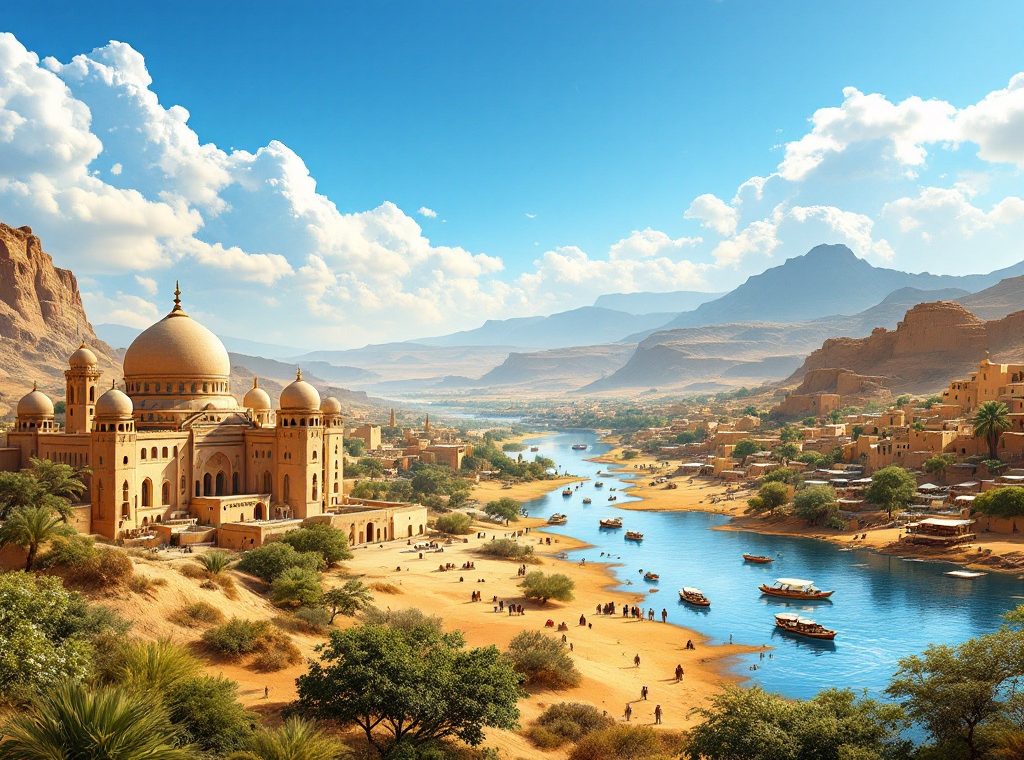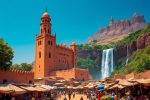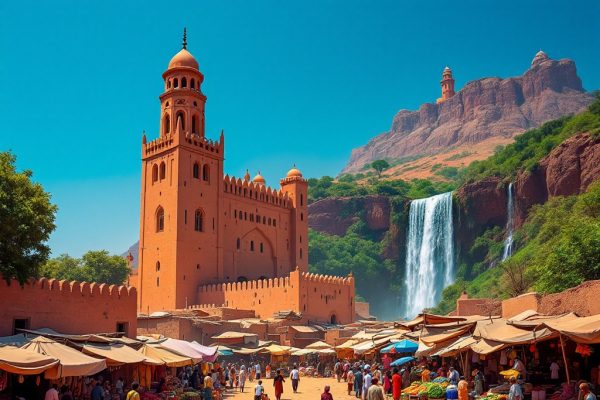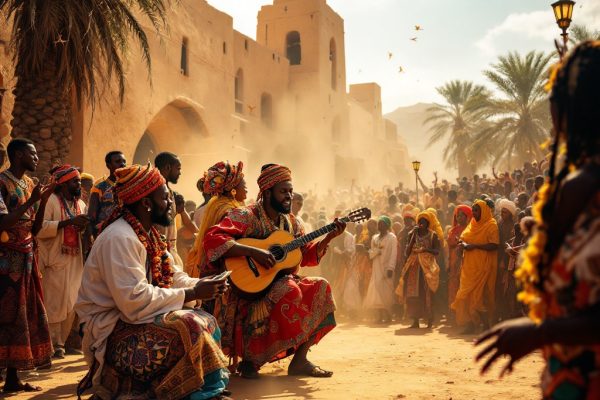Must-Visit Tourist Sites in Mali: From Timbuktu to the Bandiagara Escarpment
Journey through the heart of West Africa and discover Mali’s breathtaking landscapes and ancient wonders. Explore legendary Timbuktu, with its historic mosques and ancient manuscripts, and marvel at Djenné’s Great Mosque, the world’s largest mud-brick structure. Experience the vibrant culture of the Dogon people in the Bandiagara Escarpment and cruise the Niger River from Mopti, the “Venice of Mali”. Uncover Mali’s rich history and vibrant culture; start planning your unforgettable adventure today!
Important information
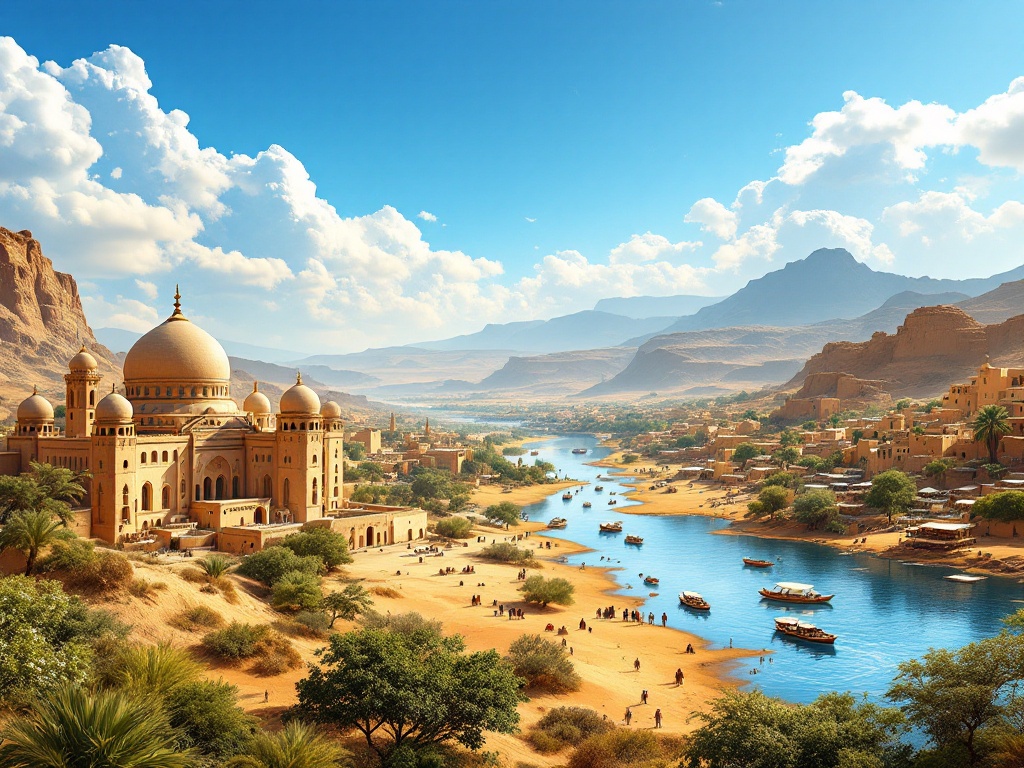
- Timbuktu, a UNESCO World Heritage site, boasts ancient manuscripts, the Djinguereber Mosque, and a rich history of trade and scholarship.
- Djenné, also a UNESCO site, features the Great Mosque, the world’s largest mud-brick structure, and traditional mud-brick homes.
- The Bandiagara Escarpment offers a unique landscape and insight into Dogon culture, including their cliff dwellings and traditions.
- Gao, the former Songhai Empire capital, houses the Tomb of Askia, a UNESCO World Heritage site.
- Bamako, Mali’s capital, offers bustling markets, the National Museum, and Niger River boat rides.
Must-Visit Tourist Sites in Mali
Mali’s cultural heritage shines through its stunning Sudano-Sahelian architecture. The Great Mosque of Djenné, a UNESCO World Heritage site, exemplifies this style. Timbuktu, a historical center of trade and scholarship, houses ancient manuscripts and the Djinguereber Mosque. Gao’s Tomb of Askia stands as a monument to the Songhai Empire. The Bandiagara Escarpment offers insight into Dogon culture with its unique cliff dwellings. Other Malian treasures include Bamako’s National Museum and the Grand Mosque of Mopti. Nature enthusiasts can explore the Boucle du Baoulé National Park.
Bamako: The Vibrant Capital
Bamako, Mali’s vibrant capital, invites you to delve into its rich history and culture. Explore bustling markets like the Grand Marché, overflowing with colorful textiles and handcrafted goods. Don’t miss Marché Rose, where you can find fresh produce, aromatic spices, and unique local crafts. The National Museum of Mali offers a fascinating journey through the nation’s heritage, providing valuable insights into its history and traditions. Complete your Bamako experience with scenic views and relaxing boat rides along the Niger River. Discover the heart of Mali in Bamako with these must-do activities:
- Visit the Grand Marché: immerse yourself in the vibrant atmosphere and discover colorful textiles and handcrafted goods.
- Explore Marché Rose: find fresh produce, aromatic spices, and unique local crafts.
- National Museum of Mali: embark on a fascinating journey through Mali’s rich history and traditions.
Enjoy scenic views and relaxing boat rides along the Niger River.
Visit the Bustling Markets of Bamako
Bamako’s markets pulse with life. Marché Rose, for instance, overflows with goods, from local crafts and vibrant textiles to fresh produce and fragrant spices. It’s a vivid snapshot of daily Malian life. The Grand Marché, renowned for its handcrafted items, is another essential stop for a genuine taste of Mali. Experience the city’s vibrant culture at these bustling markets:
- Marché Rose: Discover local crafts, vibrant textiles, fresh produce, and fragrant spices, capturing the essence of daily Malian life.
- Grand Marché: Explore a treasure trove of handcrafted items, offering a genuine taste of Mali’s artistic heritage.
Explore the National Museum of Mali
Explore Mali’s captivating heritage at the National Museum in Bamako. Discover ancient artifacts, vibrant textiles, and ethnographic objects that showcase the country’s diverse cultural tapestry. The exhibits reveal Mali’s rich history, art, and traditions, offering insights into powerful civilizations like the Mali Empire.Founded in 1953, the museum actively preserves and proudly displays Mali’s artistic legacy. Located within a tranquil garden, the museum provides a peaceful setting for reflection.
Timbuktu: The Legendary City of Learning
Timbuktu, a UNESCO World Heritage site, was a renowned center of learning and trade. It is famous for its ancient manuscripts revealing centuries of African scholarship. Key sites include the 1327 Djinguereber Mosque and the Sankore Madrasah, a prominent Islamic learning center. Visitors can explore the city’s narrow streets and local markets, experiencing its vibrant culture. The Timbuktu Manuscripts offer a glimpse into the city’s rich intellectual past, covering diverse fields like mathematics, astronomy, and literature.
Timbuktu’s Enduring Legacy
Timbuktu’s allure stems from its rich history as a hub for trade and Islamic scholarship. The city’s mosques, libraries, and manuscripts reveal this intellectual heritage, narrating a vibrant past.
The Timbuktu Manuscripts
Preserved for centuries, the incredible Timbuktu Manuscripts are a testament to West Africa’s intellectual legacy. These ancient texts explore diverse subjects such as science, religion, and law, demonstrating the region’s rich academic history and offering a window into the past.
Djinguereber Mosque
Built in 1327, the impressive Djinguereber Mosque is a testament to Sahelian architecture and one of Timbuktu’s most iconic landmarks. A UNESCO World Heritage Site, the mosque is a must-see for visitors.
Exploring Timbuktu
Visitors can explore Timbuktu’s narrow streets and local markets to experience the city’s vibrant culture firsthand.
Discover the Mysteries of Timbuktu
Timbuktu, a UNESCO World Heritage site, was a renowned center of trade and Islamic scholarship. Its narrow streets evoke a bygone era. Mosques like Djinguereber and Sankore stand as testaments to this rich heritage. The Ahmed Baba Institute safeguards ancient manuscripts, further highlighting the city’s intellectual legacy.
Djinguereber Mosque
Constructed in 1327, the Djinguereber Mosque is a key attraction for visitors to Timbuktu.
Sankore Madrasah
The Sankore Madrasah, a repository of thousands of manuscripts, also draws numerous visitors.
The Timbuktu Manuscripts offer a fascinating glimpse into West African intellectual history, covering diverse subjects such as mathematics, astronomy, and literature. These invaluable documents, along with landmarks like the Djingareyber Mosque and Sankore University, underscore Timbuktu’s historical significance and vibrant past.
Explore the Timbuktu Manuscripts and Ancient Manuscripts
Timbuktu’s ancient manuscripts unveil a vibrant history, delving into subjects like astronomy, medicine, and literature. These texts showcase the city’s rich intellectual heritage. Among Timbuktu’s key historical sites are the Djinguereber Mosque, Sankore Mosque, and Ahmed Baba Institute. These landmarks stand as testaments to its past. The Ahmed Baba Institute plays a crucial role in preserving these invaluable manuscripts, safeguarding a vital piece of history for future generations.
Visit the Historic Djinguereber Mosque
The Djinguereber Mosque, dating back to 1327, is one of West Africa’s oldest structures. Located in Timbuktu, Mali, this striking mudbrick building showcases Sudano-Sahelian architecture. It represents the city’s golden age as a prominent center of Islamic scholarship. Now a UNESCO World Heritage site, the mosque offers guided tours for visitors to explore its rich history.
Djenné: The City of Mud
Djenné, a UNESCO World Heritage site, is famous for its unique mud-brick architecture. This is best exemplified by the Great Mosque, the world’s largest mud-brick structure, a masterpiece of Sahelian design. The traditional mud-brick homes add to the city’s distinct charm. Every Monday, a vibrant market fills the streets, offering visitors a taste of local culture, from handcrafted goods to regional cuisine. Nearby, the ancient city of Djenné-Djeno reveals the area’s rich archaeological history.
Explore the Historic City of Djenné
Djenné, a UNESCO World Heritage site, is renowned for the Great Mosque, the world’s largest mud-brick structure and a truly awe-inspiring landmark. Beyond this architectural marvel, Djenné boasts a bustling market, offering visitors a glimpse into a traditional way of life. It’s a destination unlike any other.
Visit the Great Mud Mosque of Djenné
The Great Mosque of Djenné, the world’s largest mud-brick building, is a breathtaking example of Sudano-Sahelian architecture. A UNESCO World Heritage site, this remarkable structure, constructed entirely of mud, possesses a distinctive appearance and profound cultural importance. The annual re-plastering festival underscores the mosque’s significance to the community, symbolizing the rich Islamic heritage of both Djenné and Mali.
Mopti: The Venice of Mali
Mopti, Mali’s “Venice,” is situated at the meeting point of the Niger and Bani rivers. This city boasts the striking Grand Mosque, a magnificent structure built from mud-brick. From Mopti, visitors can take boat trips to witness traditional fishing practices and explore neighboring villages.
The Grand Mosque
The Grand Mosque is an architectural marvel, constructed and reconstructed annually with mud, upholding the Sudano-Sahelian style. This communal practice strengthens local traditions and presents a truly unique spectacle.
Mopti: A Vibrant Port
Mopti thrives as a bustling port at the heart of the Niger and Bani rivers, serving as a crucial transportation center. Boat trips from this dynamic city offer insights into local life, enabling travelers to visit villages, interact with fishing communities, and experience the culture firsthand.
Discover the Grand Mosque of Mopti
The Grand Mosque of Mopti, also known as the Komoguel Mosque, is a striking example of Sudano-Sahelian architecture. Constructed from adobe bricks, its most distinctive feature is the protruding wooden beams. A vital center of the community, the mosque undergoes an annual ritual where locals apply fresh mud plaster. This practice not only preserves the structure, but also strengthens community ties, representing a powerful and enduring tradition.
Sail the Waters of the Niger River
Embark on a captivating boat journey down Mali’s Niger River, typically departing from Mopti. This unique vantage point reveals stunning landscapes. Private tours often navigate past nomadic camps and vibrant fishing villages. Witness hippos in their natural habitat and gain valuable insight into the river’s rich cultures and local communities. Tour durations vary, depending on the chosen route, with longer excursions offering immersive cultural exchange opportunities.
Gao: The Ancient Songhai Capital
Gao, the former capital of the Songhai Empire, invites you to explore its rich cultural heritage. Discover the Tomb of Askia, a UNESCO World Heritage site, alongside the Gao Mosque and the vibrant local market.
Uncover the History of Gao
Gao, the ancient capital of the Songhai Empire, boasts the Tomb of Askia, a UNESCO World Heritage site. Visitors can also explore the Gao Mosque and the bustling local market.
Visit the Tomb of Askia
Askia Muhammad, emperor of the Songhai Empire, constructed the Tomb of Askia in Gao, Mali, in 1495. Now a UNESCO World Heritage site, this striking pyramidal structure showcases impressive Sahelian architecture, a unique blend of Islamic and local traditions. The tomb symbolizes both the empire’s power and its Islamic faith.
Bandiagara Escarpment: A Natural Wonder
The Bandiagara Escarpment, a UNESCO World Heritage site, is renowned for its dramatic landscape and the captivating culture of the Dogon people. The Dogon people built their villages directly into the cliffs. Stretching 150 kilometers and rising an imposing 500 meters, this escarpment offers a unique travel experience.Dogon Country, nestled along the escarpment, provides incredible opportunities for cultural immersion. Visitors can embark on multi-day treks through villages, explore ancient cliff dwellings, witness traditional ceremonies, and hike to breathtaking viewpoints. The Bandiagara Cliffs rise 500 meters and showcase the Dogon people’s architectural ingenuity and adaptability through their ancient cliff dwellings carved directly into the rock face.For centuries, the Dogon people have thrived in this environment, preserving a rich cultural heritage. Their traditions encompass art, spirituality, and distinctive agricultural practices. These traditions offer glimpses into ancient African civilizations.
Experience the Culture of Dogon Country
Embark on a journey to Mali’s Dogon Country, a unique cultural landscape perched along the Bandiagara Escarpment. Explore ancient cliff dwellings and villages, witnessing vibrant dances and traditional ceremonies. For a safe and enriching experience, choose a reputable tour company offering guided treks. These tours often include camping and locally prepared meals, immersing you in Dogon life.
Research and choose a reputable tour company: Look for companies with experienced guides, positive reviews, and a focus on sustainable tourism. This ensures a safe and culturally sensitive experience.
Plan your trek: Discuss your interests and fitness level with the tour company to determine the best itinerary for you. Treks can range from a few days to several weeks, allowing you to tailor your adventure.
Pack appropriately: Bring comfortable hiking shoes, lightweight clothing, sunscreen, a hat, insect repellent, and a reusable water bottle. A headlamp and a small first-aid kit are also recommended.
Embrace the Dogon culture: Be respectful of local customs and traditions. Ask for permission before taking photographs and be mindful of your interactions with the community. This will enhance your cultural exchange.
Enjoy the experience: Immerse yourself in the stunning landscapes, ancient villages, and vibrant culture of Dogon Country. It’s a once-in-a-lifetime adventure.
Explore the Bandiagara Cliffs and Cliff Dwellings
Mali’s Bandiagara Escarpment, a UNESCO World Heritage site, is a testament to human ingenuity. Here, the Dogon people carved homes directly into the cliffs, demonstrating remarkable skill and adaptation to the harsh terrain. This imposing escarpment stretches 150 kilometers and rises an astonishing 500 meters.
Learn About the Unique Traditions of the Dogon People
The Dogon people of Mali’s Bandiagara Escarpment are known for their fascinating traditions. Their culture includes elaborate masked dances, a remarkably advanced knowledge of astronomy, and ingenious cliff dwellings. Dogon art often portrays important figures and symbols that reflect their mythology and beliefs. Rituals and ceremonies, inherited through generations, offer a window into their rich cultural heritage. Guided tours provide valuable insights into the Dogon way of life.
Additional Must-See Sites in Mali
Mali’s Boucle du Baoulé National Park, a biosphere reserve, is renowned for its diverse ecosystems, including the Niger River. Visitors can spot elephants and hippos and enjoy scenic boat tours. Meanwhile, in Timbuktu, the historically significant Sidi Yahya Mosque showcases distinctive Sudanese architecture.
Experience Scenic Wonders at Boucle du Baoulé National Park
Boucle du Baoulé National Park offers a diverse landscape and provides a sanctuary for a variety of wildlife. As part of the larger Boucle du Baoulé Biosphere Reserve, which encompasses the Bani and Niger rivers, the park plays a crucial role in the local ecosystem. These rivers are essential, supporting a vibrant web of life.
Discover the Architectural Oddities of the Sidi Yahya Mosque
The Sidi Yahya Mosque, a striking example of 15th-century Sudano-Sahelian architecture, graces Timbuktu. Constructed with traditional mudbrick and wooden beams, it shares this distinctive style with two other significant religious centers in the city: the Djinguereber and Sankore Mosques. Named after its first imam, Sidi Yahya, the mosque has long served as a vital center for Islamic learning.

